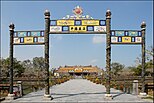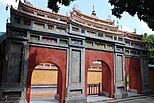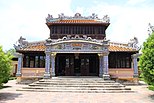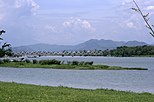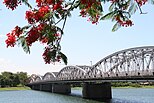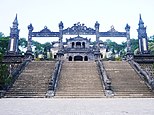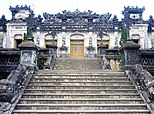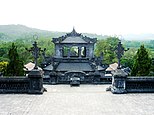Thừa Thiên Huế province
Thừa Thiên Huế province
Tỉnh Thừa Thiên Huế | |
|---|---|
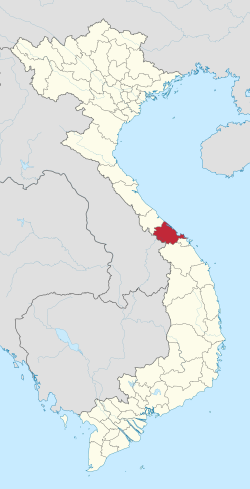 Location of Thừa Thiên Huế within Vietnam | |
| Coordinates: 16°20′N 107°35′E / 16.333°N 107.583°ECoordinates: 16°20′N 107°35′E / 16.333°N 107.583°E | |
| Country | |
| Region | North Central Coast |
| Capital | Huế |
| Government | |
| • People's Council Chair | Lê Trường Lưu |
| • People's Committee Chair | Nguyễn Văn Phương |
| Area | |
| • Total | 5,033.2 km2 (1,943.3 sq mi) |
| Population (2023) | |
| • Total | 1,272,621[1] |
| • Density | 223/km2 (580/sq mi) |
| Demographics | |
| • Ethnicities | Vietnamese, Chăm, Tà Ôi, Cơ Tu, Bru, Thai |
| Time zone | UTC+7 (ICT) |
| Area codes | 234 |
| ISO 3166 code | VN-26 |
| HDI (2012) | 0.735[2] |
| Website | thuathienhue |
Thừa Thiên Huế (Vietnamese: [tʰɨə˨˩ tʰiən˧˧ hwe˧˦] (![]() listen)) is a southernmost coastal province in the North Central Coast region, the Central of Vietnam, approximately in the center of the country. It borders Quảng Trị to the north, Quảng Nam and Đà Nẵng to the south, Salavan of Laos to the west and the East Sea to the east.
listen)) is a southernmost coastal province in the North Central Coast region, the Central of Vietnam, approximately in the center of the country. It borders Quảng Trị to the north, Quảng Nam and Đà Nẵng to the south, Salavan of Laos to the west and the East Sea to the east.
History
Between the settlement of Thuận Hóa (1306) to the founding of Phú Xuân (1687), there were conflicts and uncertainties for the local people, which including the fall of the Trần Dynasty to the renaissance of the Hồ dynasty. Thuận Hóa and Phú Xuân became the location of the Đại Việt kingdom once Nguyễn Hoàng was appointed head of Thuận Hóa (1511–1558). Lord Nguyễn Hoàng (1558–1613) established bases at Ai Tu, Tra Bat and Dinh Cat, while their lords moved palaces to Kim Long (1636), where they would eventually base their operations in Phú Xuân (1687). The Nguyễn lords ruled the area until it took over the Trinh clan in 1775. The farmers' movement led by the Tây Sơn brothers gained momentum in 1771. The Tây Sơn insurgent army won the battle in Phú Xuân to take over the Nguyễn capital in 1786, where they continued north and overthrew the Trinh Dynasty. In Phú Xuân, Nguyễn Huệ appointed themselves king, and with internal differences with the Tây Sơn Movement and the death of Nguyễn Huệ (1792), Nguyễn Ánh took advantage of the situation and took over Gia Định with the support of foreign forces. Nguyễn Ánh attached to the Tây Sơn movement and took over Phú Xuân and the throne, thereby choosing the dynasty title of Gia Long (1802). Phú Xuân was again chosen as the capital of Vietnam until 1945's August Revolution.[3]
The province is known as an area of fighting during the Vietnam War, as it was the second-most northerly province of the South Vietnam, closer to the North Vietnamese border (DMZ) at the 17th parallel. More U.S. soldiers died in this province than in any other province in Vietnam (2,893).[4]
Geography
The Perfume River (called Sông Hương or Hương Giang in Vietnamese) passes through the center of province. The province accommodates the Tam Giang–Cau Hai lagoon, the largest lagoon in Southeast Asia, which is 68 kilometres (42 mi) long with a surface area of 220 square kilometres (85 sq mi). The province comprises 4 zones: a mountainous area, hills, plains and lagoons separated from the sea by sandbanks. It has 128 kilometres (80 mi) of beaches. The mountains, covering more than half the total surface of the province, are along the west and southwest border of the province, their height varying from 500 metres (1,600 ft) to 1,480 metres (4,860 ft). The hills are lower, between 20 metres (66 ft) and 200 metres (660 ft), with some points at 400 metres (1,300 ft), and occupy about a third of the province's area, between the mountains and the plains. The plains account for about a tenth of the surface area, with a height of up to 20 metres (66 ft) above sea level. Between the hills are the lagoons which occupy the remaining 5% of the province's surface area.[5]
Bạch Mã National Park is a protected area near the city of Hué. It covers 220 square kilometres (85 sq mi) and comprises 3 zones: a protected core area, an administrative area and a buffer zone. The climate is similar to central Vietnam in general: a tropical monsoon climate. In the plains and in the hills, the average annual temperature is 25 °C (77 °F), and in the mountains 21 °C (70 °F) (statistical yearbook 2004). The cool season is from November to March with northeasterly winds. The lowest average monthly temperature is in January: 20 °C (68 °F). In the cool season temperatures can fall to 12 °C (54 °F) in the plains, and humidity is between 85 and 95%. Then follows a warmer period from April to September with average monthly temperatures up to 29 °C (84 °F) in July, reaching up to 41 °C (106 °F) at times. In July, relative humidity is lower, sometimes down to 50%.[6]
The annual precipitation in the province is 3,200 millimetres (130 in) and there are variations. Depending on the year the annual average may be 2,500 millimetres (98 in) to 3,500 millimetres (140 in) in the plains and 3,000 millimetres (120 in) to 4,500 millimetres (180 in) in the mountains. In some years the rainfall may be higher and reach more than 5,000 millimetres (200 in) in the mountains.[5] The rainy season is from September to December—about 70% of the precipitation occurring in those months. Rainfall occurs in bursts which can cause flooding and erosion. The floods of November 1999 led to 600 deaths and affected 600,000 homes. (Comité des inondations, 1999).[7][8]
Flora and fauna
A region known as the "Green Corridor" is home to species. Species of snake, butterfly, and orchid have been found there in 2005 and 2006, as stated by Chris Dickinson of the World Wide Fund for Nature (WWF) on 26 September 2007.[9][10] The scientists discovered 11 new species of plants and animals, including a snake, 2 butterflies and 5 leafless orchid varieties. The snake species is a white-lipped keelback (Hebius leucomystax). The butterfly species are a skipper from the genus Zela and the other from Satyrinae. The plant species include 1 in the genus Aspidistra, and a poisonous Arum perennial.[11]
Administrative divisions
Thừa Thiên Huế is subdivided into 9 district-level sub-divisions:[12]
- 6 districts:
- 2 district-level towns:
- 1 provincial city:
- Huế (capital)
Demographics
The average population of the province is 1.143.572, which consist of approximately 567.253 males and 576.319 females. The rural population is approximately 587.516 while the urban population is 556.056 (2015).[13]
| Largest cities or townships in Thừa Thiên Huế province (2015) | ||||
|---|---|---|---|---|
| Rank | Name | Type | District | Population |
| 1 | Huế | City | 354,124 | |
| 2 | Hương Trà | Town | 116,147 | |
| 3 | Hương Thủy | Town | 101,353 | |
| 4 | Thuận An | Township | Phú Vang district | 21,220 |
| 5 | Phú Đa | Township | Phú Vang district | 12,381 |
| 6 | Lăng Cô | Township | Phú Lộc district | 12,177 |
| 7 | Phú Lộc | Township | Phú Lộc district | 10,613 |
| 8 | Sịa | Township | Quảng Điền district | 10,583 |
| 9 | A Lưới | Township | A Lưới district | 7,393 |
| 10 | Phong Điền | Township | Phong Điền district | 6,743 |
| 11 | Khe Tre | Township | Nam Đông district | 3,818 |
Economy
The retail sales of goods and services (trade, hotel, restaurant, tourism) in the province is 10960.6 billion đồng or 0.9% of the country. This is compared with 12.7% for Hanoi and 23.5% for Ho Chi Minh City (2009).[14] The province has more than 120 km of coastline, which provides for a seafood industry that produces over 40,000 tonnes/year consisting of over 500 species of fish.[15]
There are more than 100 mines for minerals and non-mineral resources with the majority consisting of limestone, granite and kaolin.[16]
Historical buildings are located in Huế, largely a legacy from its time as a capital of the Nguyễn dynasty (1802–1945), including the Royal Citadel, the Flag Tower, the Royal Palace, and the Royal Tombs. Huế's Forbidden Purple City was once reserved for the royal family. Outside the city is the religious site known as Nam Giao Hill ("Heaven's Altar"). Hue Brewery Ltd is located on Hương Giang in Huế with a recognizable brand in central Vietnam. The Brewery is jointed owned by the state and private sector and was founded in 1990 with an initial investment of US$2.4 million with a capacity of 3 million liters/year, which has grown to a capacity of 100 million liters/year in 2007.[17]
Education
This city is home to Huế University (e.g.: Huế Economic University, Huế Medicine University, Huế Pedagogical University, Huế Forestry and Agriculture University, Huế University of Sciences, Huế University of Arts, Huế Conservatory of Music and Huế College of Foreign Languages). As of 2009 the province had 190 schools, 1302 classrooms, 2184 teachers and 36,200 pupils.[18]
International relations
Sister cities
Thừa Thiên Huế is twinned with:[19]
 Bandar-e Anzali, Gilan province, Iran[20]
Bandar-e Anzali, Gilan province, Iran[20] Blois, Centre-Val de Loire, France[21]
Blois, Centre-Val de Loire, France[21]
 Honolulu, Hawaii, United States'[22]'
Honolulu, Hawaii, United States'[22]'
 New Haven, Connecticut, United States'[22]'
New Haven, Connecticut, United States'[22]'
 Phra Nakhon Si Ayutthaya, Thailand[23]
Phra Nakhon Si Ayutthaya, Thailand[23]
 Quebec, Canada
Quebec, Canada
 Rennes, Brittany, France
Rennes, Brittany, France
 Yogyakarta, Java, Indonesia
Yogyakarta, Java, Indonesia
References
- ^ "General Statistics Office Of Vietnam". Gso.gov.vn. Retrieved 2013-06-22.
- ^ "Growth that works for all: Viet Nam Human Development Report 2015 on Inclusive Growth" (PDF). United Nations Development Programme. January 2016. pp. 173–174. Archived from the original (PDF) on 31 August 2018. Retrieved 31 August 2018.
- ^ "Thua Thien Hue some facts on historical establishment and development". Thừa Thiên Huế province government website. Archived from the original on 3 October 2011. Retrieved 26 September 2011.
- ^ http://www.rjsmith.com/kia_tbl.html" Archived 2010-04-15 at the Wayback Machine
- ^ a b Atlas des lagunes de Thừa Thiên Huế, 2003
- ^ Villegas 2004
- ^ Villegas, Piero (2004). "Flood modelling in Perfume river basin, Hue province, Vietnam" (PDF).
{{cite journal}}: Cite journal requires|journal=(help) - ^ Integrated Management of Lagoon Activities Project - an FAO sustainable lagoon management project in the province.
- ^ Recent news release by WWF
- ^ The Green Corridor Project Archived 2007-09-15 at the Wayback Machine - a WWF conservation endeavor located in the province.
- ^ "Yahoo.com, Scientists find new species in Vietnam".
- ^ "Districts & Hue City". About Government / Administrative system. ThuaThienHue province. Retrieved 16 November 2011.
- ^ "Population and Employment". Monthly Statistical Information. General Statistics Office of Vietnam. Retrieved 16 November 2011.
- ^ "Retail sales of goods and services at current prices by province". Statistical Data. General Statistics Office of Vietnam. Retrieved 16 November 2011.
- ^ "Potentials and perspective". About Thừa Thiên Huế Province. Thừa Thiên Huế Portal. Retrieved 16 November 2011.
- ^ "Geographical conditions and natural resources". About Thừa Thiên Huế Province. Thừa Thiên Huế Portal. Archived from the original on 31 March 2012. Retrieved 16 November 2011.
- ^ "About Us". Hue Brewery Ltd. Retrieved 16 November 2011.
- ^ "General Statistics Office Of Vietnam". Gso.gov.vn. 13 August 2010. Retrieved 13 August 2012.
- ^ "Hué, Thừa Thiên-Huế, Vietnam - City, Town and Village of the world". en.db-city.com. Retrieved 2023-03-23.
- ^ "شهرهای بندر انزلی و هوء در ویتنام خواهر خوانده شدند". www.aftabir.com (in Persian). aftabir. 19 July 2004. Archived from the original on 19 August 2019. Retrieved 17 December 2016.
- ^ "Jumelages et coopérations" (in French). Retrieved 20 February 2017.
- ^ a b "Hue, Vietnam". Sister Cities International. Archived from the original on 23 March 2014. Retrieved 22 March 2014.
- ^ Chicha (23 May 2013). "บ้านพี่เมืองน้อง อยุธยา-เมืองกุม" [Sister City 'Ayutthaya-Muang Kum'] (in Thai). bangkokbiznews.com.
External links
- Webarchive template wayback links
- CS1 errors: missing periodical
- CS1 Persian-language sources (fa)
- CS1 French-language sources (fr)
- CS1 Thai-language sources (th)
- Articles with short description
- Coordinates not on Wikidata
- Articles with hAudio microformats
- Official website not in Wikidata
- AC with 0 elements
- Thừa Thiên Huế province
- North Central Coast
- Gulf of Tonkin
- Provinces of Vietnam





